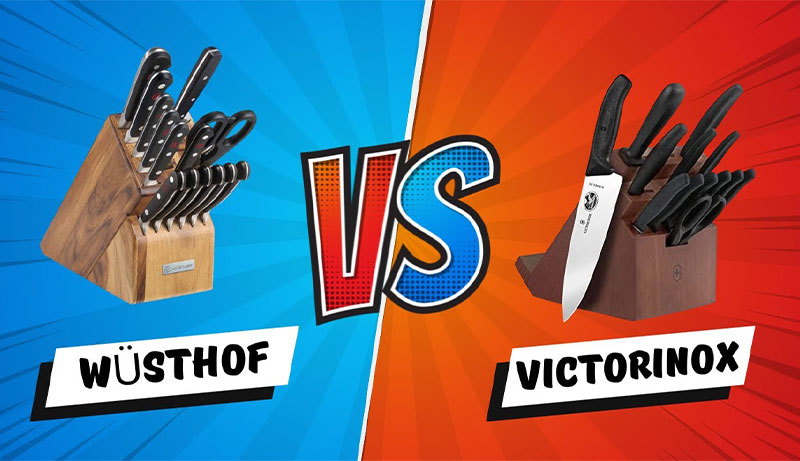As an affiliate, we may earn a commission from qualifying purchases. We get commissions for purchases made through links on this website from Amazon and other third parties.
Are you trying to choose between Wusthof and Victorinox when buying a new pair of high-quality kitchen knives?
Both companies are well-known for producing kitchen knives that are incredibly sharp, elegantly designed, and extremely durable.
Nevertheless, despite their similarities, Wusthof and Victorinox knives differ significantly, and you should be aware of these differences before making a purchase.
You can compare the kitchen knives made by Victorinox and Wusthof to see how they compare in terms of overall value, design, sharpness, durability, and a variety of other factors.
By the time it’s over, you’ll be fully equipped with the knowledge need to buy a property with confidence.
Let’s begin straight away.
| Preview | Product | Rating | Price | |
|---|---|---|---|---|

|
WÜSTHOF Classic 15-Piece Knife Block Set | $1,170.00 | CHECK PRICE | |

|
Victorinox Swiss Classic 14-piece Swivel Knife Block Set | $299.95 | CHECK PRICE |
Wüsthof vs Victorinox
Here are the key details you need to be aware of if you’re looking for a quick comparison of Victorinox vs. Wusthof.
Corporate Overview: Abraham Wusthof established the family-run company Wusthof in Solingen, Germany, in 1814. They are one of the most well-known and regarded companies and have a great reputation for producing high-quality kitchen and office knives. The Swiss Army Knife is Victorinox’s most famous product, and the company is also family-owned. It was founded in 1884 by Karl Elsener I. Their product lines include watches, travel accessories, fragrances, and knives (pocket and kitchen).
Wusthof has seven knife collections, six of which are forged and one stamped. Four stamped and one forged knife collections make up Victorinox’s five offerings. Knives that have been forged are thicker, heavier, and tougher. Stamped knives have thin, lightweight blades that are frequently exceedingly sharp.
Wusthof’s designs mix elegance and utility. The ergonomically shaped handles are all firmly attached and provide a better grip. Victorinox offers a stunning variety of grip designs and colors, as well as interesting blade forms. Victorinox has a more stylish brand than the other.
Materials: A special alloy of stainless steel, carbon, chromium, molybdenum, and vanadium is used to make Wusthof blades. This mixture maintains the blade’s proper hardness and keeps it exceptionally durable, corrosion-free, and stain-free. Handles are made of wood, wood-composite material, and artificial materials. In order to produce hardness and corrosion resistance, Victorinox blades are produced from a proprietary mix of chromium and molybdenum-alloyed special steel. The handles on Victorinox knives are constructed of wood or plastic.
Weight and Balance: Due to the full-length blades and bolsters (the thick area between the blade and handle), forged knives are frequently heavier than stamped knives. Victorinox mostly produces stamped knives, whereas Wusthof primarily produces forged knives. Victorinox items often weigh a little bit more when compared to stamped and forged knives from both brands.
Sharpness: Wusthof knives have an edge angle between 10 and 14 degrees per side when they leave the manufacturer, making them sharper. Edges on Victorinox knives are honed by 15 to 20 degrees on either side. As a general rule, the edge will be sharper the smaller the angle.
Price: Wusthof knives cost more than Victorinox knives, however stamped knives from both lines are less expensive than forged blades (skip to price comparison chart).
Bottom Line
Choose Wusthof if you have extra cash to spare. It will endure longer and maintain its sharpness. Try the Victorinox Fibrox or Wusthof Gourmet if you’re on a tight budget. You may trust that since they are stamped knives made with assistance from kitchen pros, they will easily manage your daily needs.
